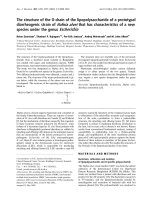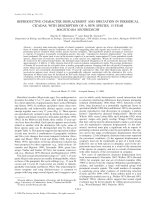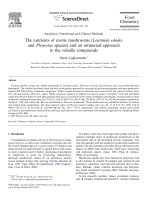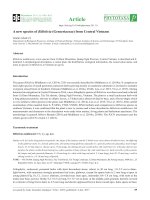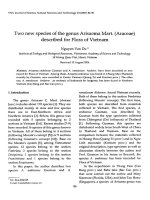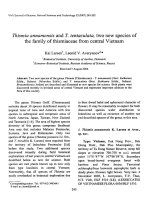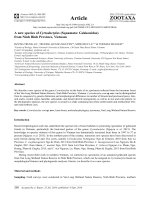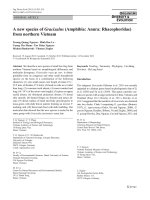ILLUSTRATIONS OF NEW SPECIES OF EXOTIC BUTTERFLIES V2, HEWITSON
Bạn đang xem bản rút gọn của tài liệu. Xem và tải ngay bản đầy đủ của tài liệu tại đây (10.77 MB, 260 trang )
£'nt
ILLUSTEATIONS
OP
NEW SPECIES
OF
EXOTIC BUTTERFLIES,
SELECTED CHIEFLY FROM THE COLLECTIONS OF
W. WILSON SAUNDERS and WILLIAM
BY
WILLIAM
C.
VOL.
C.
HEWITSON.
,„^h
HEWITSON
II.
JOHN VAN VOOEST, LONDON.
1857—1861.
(^c^bA-S
LONDON
:
WOODFALL AND KINDER,
PRINTEIIS, ANGEI. COURT,
SKINNER STREET.
INTRODUCTION.
The
work has been
author's sole object in the production of this
correct pictorial representations of the exquisite things
through
He
life.
believes that there
to leave behind
him
which have been to him a
jo}'^
nothing higher or more worthy of
is
his
He
ambition than the simple child-like study of the works of his and their Creator.
beheves each species in itself perfect
Creator
and
;
if
and
as
it
first
came from the hands of the
he could believe in the transmutation of species or that there was
one grain of truth in the chaotic jumble of Mr. Darwin, his life-long pleasure and
He
occupation would be taken from him.
has himself experienced so
much
pleasure
in identifying
from a good figure any species which descriptions have
elucidate, that,
encouraged by his own experience and the kind aid of his friend, Mr.
Wilson Saunders, who bears half the
to proceed with a third volume.
At
loss sustained in its publication,
commencement
the
the study of the Diurnal Lepidoptera had been so
were crowded with undescribed species
much
he
failed
is
to
induced
of this work, ten years ago,
neglected that our collections
except in England, where the " Genera of
;
Diurnal Lepidoptera " had just been brought to a conclusion, scarcely anything had
been done of
late years
towards their
illustration.
Since then
Dr. Boisduval has described the butterflies of California;
the
" Revue
numerous
Imperial
Magasin de Zoologie
et
species
Museum
;"
of St. Petersburg
;
790
figures) have
been given
Horsfield and
than 500) remain imnamed.
of islands,
in this
publication of this
work
is still
The author cannot allow
;
to Dr.
Gray
and figured
Moore have described and
Museum
412 new
;
illus-
species
work, and yet numbers of species (not
Mr. Wallace
expressing his sincere thanks to those
several species in
described
exploring the
New
and abundant materials arc accumulated from which to
for our third volume.
has been done.
a Catalogue of the Lepidoptera in the
trated the Butterflies in the collection of the East Lidia
(with
M. Lucas
Dr. Felder has
M. Menetries has published
;
much
who have
less
Guinea group
select illustrations
this opportunity to pass without
so kindly aided
for the facilities of access
him during the
which have been
INTRODUCTION.
iv
Museum
given him over the collection of the British
Bates,
were
and
his
to
Mr. Wallace, whose
collections
;
to Dr. Eoisduval,
he has had access to as
freely as
to
Mr.
if
they
own.
CORRECTIONS.
Pieris Eliada
Pieris
is
the male of Cramer's P. Liberia.
Cycinna has been incorrectly printed P. Concinna
Cycinna
Leptalis
is
the
name by which
Antherize, of Boisduval,
the author wishes
is
N.B.
—An Lulex
Plates, as in the "
A
is
P.
(Annals
Soc.
3.)
Lampetia of Cramer, Plate 349.
given,
by which the binder wUl be enabled
second Lidex, alphabetically arranged,
1 to 120), after the
N.B.
known.
to arrange the
Genera of Diurnal Lepidoptera."
will take tlie trouble to
la
is
to be
the description.
L. Portunata of Lucas
Entom., 3rd Series, Vol. IL, Plate
Messaras Maonites
it
in
number
is
given for the benefit of those
the Plates (from 1 to
book has been arranged by the
—On append un Index
par lequcl
first
le relieur
60) and the
who
letterpress (from
Index.
peut arranger
les planclies
de
maniere qu'en " Genera of Diurnal Lepidoptera."
meme
On append un
second Index, arrange alphabetiquement, pour servix a ceux qui
veulent mettre les nombres aux planches
qu'on aura arrange
le
(1
a 60), et aussi au texte (1 a 120), apres
hvre par I'aide du premier Index.
Oatlands, Walto>"-on-Thames,
Sept. 13, 18G1.
ITHOMIA^ XW.
o o
5 071..
islet J-itK 18 55
c^l.ITHOltoA
82.
83
PriiLtel
ERRrCA
JTHOMIA DIAPHANUS.
ITHOMIA ESITLA
ToyHuUmsaiJel
&.
TValton
84ITHOMIA C^NO
.85
ITHOMJA ONEIIA
86
ITHOMLA SALONIKA
HEL
I
C O
ITHOMIA.
N I D .E.
XIV.
ITHOMIA ERRUCA.
81.
Male transparent glossy lilac-white the uervures and margins
narrow, short, almost perpendicular band at the end of the cell.
Underside rufous, where black above.
Expan. 1^^ in. Hab. Rio Grande.
Upperside.
;
A
black.
lu the Collection of W. C. Hewitson.
Though very nearly allied to I. Adasa, Fig.
This species is more elegant in its form,
narrower and more nearly perpendicular.
together.
cell
43, they are very easily distinguished
is
ITHOMIA DIAPHANUS.
P. Diap/ianws. Brury,
Vol. 2. Fl.
7.
when seen
veiy glossy, and has the band at the end of the
82.
P. Blaphana. Cramer,
PL
231.
Upperside. Male transparent glossy rufous-white ; the margins, which are very
Anterior wing with a narrow
narrow, and the nervures, which are very fine, black.
oblique band at the end of the cell.
Underside rufous where black above.
Expan. 2-2^ in. Hab. Jamaica.
In the Collection of the British Museum.
ITHOMIA ESULA.
Upperside.
Male transparent rufous-white
83.
;
more deeply
tinted towards the
anal angle of the posterior wing.
The margins (except the costal margin of the anterior wing, which
the nervures black.
Underside with the margins
wing, which
is
in.
In the Collection of
rufous)
and
rufous, except the costal margin of the posterior
from the base to beyond the middle.
Hab. New Granada.
W. C. Hewitson.
A A
dull yellow
Expan. 2^^
is
HELICONID^
ITHOMIA.
ITHOMIA CCENO.
/.
Coeno.
BouUeday
Sf
84.
Hexoitson Gen. Diur. Lep. PI. 18.
Female.
Male transparent purple-white; the marguis and nervures blue-
TJppERSiDE.
black, except the anal angle of the posterior wing which is orange.
Posterior wing,
from the inner margin near the base to the middle, tinted with yellow. Both wings
with a submarginal row of indistinct white spots.
Underside as above, except that the marginal white spots are more distinct.
'Expan. 2x^j in.
Hab. New Granada.
In the Collections of W. W. Saunders and W. C. Hewitson.
spot on the margin of the posterior wing is not a sexual distinction although it maybeautify the males only, they are usually without it.
I have seen only one example of the variety,
which I have figured, which has the antennae (commonly black) orange from the middle to the tip.
The orange
;
ITHOMIA ONEIDA.
85.
IJpPERSiDE.
Female semi-transparent, rufous
Anterior
the margins black.
wing slightly clouded beyond the middle, with the costal margin and the nervures,
to beyond the middle of the wing, rufous
the ends of the nervures black. A lunular
black spot at the end of the cell.
Posterior wing, with the nervures (except the discoidal nervulc, which is rufous), black.
Underside light rufous, where black above. The costal margin of the postei'ior
wing dull yellow the outer margin of the same wing black, varied with rufous spots
at the end of each uervule.
The nervures of both wings darker than above. Anterior wing with three distinct white spots at the apex
posterior wing with six large
lunular spots on the outer margin.
Expan. 2-^0 in.
Hab. New Granada.
In the Collection of W. C. Hewitson.
This and the two preceding butterflies were sent me by Mr. T. J. Stevens, of Bogota, to whose
;
;
;
;
love of entomology we are indebted for
have lately been enriched.
some
of the
most beautiful acquisitions with which our cabinets
ITHOMIA SALONINA.
86.
Upperside. Female transparent rufous white ; the margins and nervures (except where they cross the yellow band) brown.
Anterior wing with a short oblique
band at the end of the cell, joined to the outer margin by two broad nervules, and
followed by a broad indistinct band of pale yellow.
Underside
and the
costal
as above, except that the outer
margin
Expan. l\l
in.
at the base of the posterior
Hab.
margins of both wings are rufous,
wing orange.
Bolivia.
In the Collection of the British I\Iuseum.
Very nearly
allied
to
I.
Salapia, Fig.
the nei'vures of the jsosterior wiug.
15,
but easily
known from
it
by the arrangement of
MIEILE€(0)liIIDiS
ITHOMIAXT.
"vV"
C H.ewit«(m., del. eiHth. 1855.
87.
8S.
ITHOKIA HYALA
89.
ITHOMIA LAGUSA
91
92.
90
I'
93
T
HELICONIDtE.
ITHOMIA
XV.
ITHOMIA HYALA.
87, 88.
Male transparent riifons-wliite the nervures and margins black.
with an indistinct uari'ow band across the cell, and a broad curved
band at the end of the cell, produced beyond the median nervule black. The usual
The space between the inner margin
white spot on the costal margin very small.
and the median nervure and its first nervule, unusually broad (narrow in the female)
and light brown. Posterior wing unusually small (larger in the female).
Underside (except the nervures) rufous, where black above. The apex of both
wings with minute white spots, sometimes seen above. The costal margin of the
posterior wing broadly orange (narrower and rufous in the female).
Expan. 2 in. Hab. Guayaquil.
Uppeuside.
Anterior
;
mng
In the Collections of W. W. Saunders and W. C. Hewitson.
I have figiu-ed both sexes, to point out more clearly
This will come next to I. Diasia (Fig. 28).
than I can by description, the difierences which exist. In the female the disco-cellular nervules cross
In the male these
the posterior wing transversely and at a right angle with the costal niai'gin.
nervures are much lower down, cross the wing obliquely, and join the costal margin nearer the apex,
and at an acute angle.
I have ascertained, since figuring the beautiful Ithomia SteUa, at Fig. 52, that the nenaires
The female of I. Stella
of the posterior wing differ in the opposite sexes exactly as in this species.
is fiy-ured.
ITHOMIA LAGUSA.
89.
Upperside. Female transparent rufous-white the margins (except the inner
margin of the anterior wing, near its base, which is rufous) black. Anterior wing,
with the space between the inner margin and the median nervure, and its first
nervule, orange
the nervnres (except the median nervure to its first branch), an
oblique band at the middle of the cell, and a broad, irregular, transverse band at the
;
;
end of the
cell,
black.
Underside
Two
indistinct spots of white at the apex.
as above, with the base of the posterior
of both wings with very distinct round
The male I have i t seen.
Expan. 2i^ in. Hab. New Granada.
In the Collection of W. C. Hewitson.
Nearly allied to Ithomia Avella, Fig. 27.
wing yellow.
submargmal white
spots.
The margins
;
.
HELICONID^
ITHOMIA.
ITHOMIA LARINA.
90.
Upperside. Male. Anterior Aving with a large space at the base orange
a spot in the cell, and the rest of the wing black, with several white spots
one
(a donble triangle) in the cell
two below it, between the median nervules two (the
;
;
;
of which is large and trifid) placed obliquely across the wing beyond the middle,
and a snbmarginal row, white, or slightly tinted. Posterior wing orange, with the
outer margin, and a band of three spots, placed longitudinally across the middle,
black.
A transparent spot near the apex, bounded by the black already described,
and a line of black near the costal margin. Three small white spots near the
first
apex.
Underside
margin
Expan. 2-2%
differs
only in having a continuous row of white spots on the outer
Hab. Ncav Granada.
in.
In the Collection of W. C. Hewitson.
If this species was not also a male I must have placed it as the female of Ithomia Celemia,
Fig. 22, to which it bears such close resemblance in its general aspect.
Besides the black spots and
different position of the uervures of the posterior wing, the shape and relative proportions of the two
wings are very different.
ITHOMIA IPHIANASSA.
Ithomia Iphianasm.
91, 92, 93.
BoiMeday and Hewitson.
Plate
Gen. Diiir. Lep.
18.
Upperside. Male (Fig. 92). Anterior wing, from the base to beyond the
middle (except the margins, and two black spots, one of which crosses the end of
the cell), semi-transparent rufous. The rest black
crossed before the apex by a
cm-ved band of yellow, and an oblong transparent spot between the second and third
median nervules. A curved hue of orange near the outer margin, and two or three
white spots at the apex.
Posterior Ming, Avith the basal half transparent rufous;
white, with a small black spot at the end of the
a band of orange, parallel to the outer margin.
Underside
as above, except that
cell.
The
rest black
;
traversed
by
both wings have a submarginal row of white
spots.
The female does not
differ.
Figures 91 and 93, varieties from
Expan. 272-0 i"- Hab. Venezuela.
In the Collections of
New
Granada.
W. W. Saunders and W. C
Hewitson.
repeated here although previously published in the genera of
Dimnial Lepidoi)tera. to make this series as complete as possible, and also to bring it into juxtaposition with Figures 1>1 and 93, which I believe to be varieties of the .same species, their only
difference consisting in the quantity of black with which the wings are suffused.
I have both sexes
of each of the varieties.
The
figure of this species
is
ITHOMIA. X7I
W C lie:^tson, ael etlttii.lSSS.
94.95,96
97.
"Pa^nteiToy HuTXTnajridel &'Wa2'tcm.
ITHOMIA ZERLINA 98. ITHOMIA G-EPHIRA
ITHOMIA lOLAIA. 99. ITHOMIA OCALEA,
100 ITHOMIA &0HIJS6A.
HEL
I
C O
N
ITIIOMIA.
I
D ^.
XVI.
X'lTHOMIA ZERLINA.
94, 95, 96.
Upperside. Male (Fig. 96) transparent white, slightly clouded beyond the
The margins (which are broad) and the nervures black. Anterior wing,
middle.
with a broad band at the end of the cell, black.
Underside bright rufous (sometimes edged with black), where black above the
apex of the anterior wing, and the outer margin of the posterior wing distinctly
;
spotted with white.
Female (Fig. 95), with the margins broader; sometimes clouded at the angle
formed by the median nervure and its first nervule on the anterior wing, and at the
disco-cellular nervules of the posterior wing.
Variety, female. Fig. 94.
Expan. 2 to 2yo
Hab.
in.
New
Granada.
In the Collection of W. C. Hewitson.
Although Fig. 94 differs considei-ably in colom- from the other
am
correct in considering
it
as a variety of the
same
species.
ITHOMIA lOLAIA.
figures, I
have no doubt that
I
It is a female.
97.
Upperside.
Female semi-transparent. Anterior wing, from the base to near the
the rest semi-trans])arent black, Avith seven round or oblong, slightl}'
tinted white spots
a black spot in the middle of the cell.
Posterior wing rufous,
with an oblong spot below the cell and the outer margin, black.
Both wings with a
middle, rufous
;
;
submarginal row of slightly tinted white spots.
Underside
Expan.
as above.
2-2-0 i".
Hab.
New
Granada.
In the Collection of W. C. Hewitson.
This species, though voiy distinct, bears considerable resemblance to the beautiful Ithomia
Fig. 52.
Stella,
ITHOMIA GEPHIRA.
98.
Upperside. Female. Anterior wing with a large space at the base orange,
with a spot of white near the end of the cell the rest black, with several longitudinal
transparent spots of rufous-white
the first (nearest the costal margin) large and
trifid
the second (in the middle) short
the third and fourth long, and clouded in
;
;
;
;
;
HELICONID^
— ITHOMIA.
The apex with four distinct white spots. Posterior wing, from the
the middle.
base to beyond the middle, orange
the rest black, with three oblong spots (two
transparent), and a snbmarginal row of bifid white spots.
Underside as above, except that tlie black at the end of the cell of the anterior
wing is intersected with a rufous line.
The male differs only in having the posterior wing so much more narrow, that
it is without the oblong spot near the costal margin, and the single white spot at the
;
apex.
Expan.
2^ in.
In the Collection of
Hab.
W. C.
New
Granada.
Hewitson.
ITHOMIA OCALEA.
Ithomia Ocalea.
DoMeday and
Hewitson.
99.
Gen. Diur. Lep.
Plate
18.
Upperside. Female semi-transparent. Anterior wing, from the base to beyond
the middle (except the margins, which are black) rufous
the rest black, crossed by
a curved band of five unequal oblong spots of light yellow.
The third spot shorter
;
than the rest; the fourth and
indistinct Avhite spots.
Underside
and
fifth
Posterior
joined to the rufous space.
wing
rufous, with the outer
Apex with
three
margin black.
wing has a line of black near
margin, and a row of bifid white spots near the outer
as above, except that the posterior
parallel to the costal
margin.
The male does not diff'er.
Expan. 'Iyo "iHab. Venezuela.
In the Collections of W. W. Saunders and
W.
C. Hewitson.
ITHOMIA GONUSSA.
100.
Upperside. Female. Anterior wing (partly semi-transparent) black.
The cell
(which has an indistinct band across the middle), and a spot between it and the
inner angle, light orange
a triangular spot near the middle of the costal margin
;
small spot below
a row of irregular-shaped spots parallel to the outer
margin, yellow-white.
A snbmarginal roAV of distinct white spots. Posterior wing,
with the basal half orange, the rest black, with a snbmarginal row of large distinct
white spots.
a
Underside
Expan.
it,
and
as above.
New
Hab.
Granada.
2-po in.
In the Collection of W. C. Hewitson.
This beautiful Buttei-fly is veiy distinct from any of the numerous species figured hitherto.
form only it somewhat resembles Fig. 49.
In
:EiLS€(Difiin),
ITHOMIA. XYII
WC.Hewitson,
del. et litli.
1656
Prjiitel loy HullTna.-nd«a
lOI.
102 103. 104,
&Walto
ITHOMIA UTILLA
ITHOMIA PHENOMOE
105.106.
107
ITHOMIA MAKF
HELICONIDtE.
ITHOMIA.
ITHOMIA UTILLA.
Upperside.
wing rounded
defined
Female
at the
apex
band of brown,
XVII.
lilac- white,
with the margins and nervures black.
slightly clouded
;
end of the
at the
beyond the middle
;
Anterior
an indistinct,
ill-
cell.
Underside, with the margins, except the
rufous.
101.
costal
margin of the anterior wing,
Anterior wing, with two or three white spots at the apex.
Expan.
1 j;^ in.
Hab.
In the Collection of W.
New
Granada.
C. Hewitson.
/ITHOMIA PHENOMOE.
/.
BoMeday and Ilewifson,
Phenomoe.
Upperside.
Male
lilac-white
;
102, 103, 104.
Gen. Diur. Lep.
Plate
the margins and nervures black.
18.
Anterior wing,
with a slight cloud surrounding some indistinct spots of white near the outer margin
crossed at the end of the
cell
cell
by a triangidar band
by a short hne of the same
and
at the
middle of the
colour.
Underside, rufous where black above.
Anterior wing with three or four white
spots (one on the costal margin) at the apex.
two
of black,
;
Posterior
wing with sometimes one
or
spots at the apex.
Pemale, with the wings wider, the band at the end of the
and quadrate
Expan.
;
the line across the middle of the cell longer and
\\'i^ in.
Hab. Venezuela.
In the Collections of W. \V. Saunders and
W.
C. Hewitson.
cell longer,
much more
broader,
distinct.
HELICONIDiE
ITHOMIA MAKRENA.
y
Makrena.
I.
Male
Upperside.
— ITIIOMIA.
105, lOG, 107.
Hewitson Exot. But. Ithomia,
lilac-
or rufous-white.
29
and
59.
The nervures and the margins (which
Anterior wing, with a slight cloud near the outer margin, sur-
are broad) black.
rounding some indistuict spots of white (two of which,
enclosed by a line of black)
the end of the
Fiffs.
cell,
a line at the middle of the
;
at the apex,
cell,
are sometimes
and a triangular band
at
black.
Underside bright rufous where black
above.
The apex
and the outer margin of the posterior wing, with white
Females
at figs.
Expan.
\\^
of the anterior wing,
spots.
29 and 59.
Hab.
to 2-2%.
New
Granada.
In the Collection of W. C. Hewitson.
This species and
I.
reference to the underside.
posterior wing, which
Pheuomoe, although
I.
differing
Makrena has always a row
Phenomoe
is
without.
but
little
above, are easily distinguished by-
of white spots near the outer margin of the
MmiLIIWSflllQ)^,
ITHOMIA XYni
Prmtei IjyHullinandeL fcTftiltoK
WC.Hewitsoi!
109.
no.
Ill
ITHOMIA LILLA
ITHOMIA SAO
Il§
113.
ITHOMIA VIRGINIA
ITHOMIA ZELICA
HELICONIDtE.
ITHOMIA.
XVIII.
ITHOMIA LILLA.
lOS.
Upperside. Female transparent purple-white, both wings tinted with yellow
The margins and the nervures (except where they cross the yellow
within the cell.
band of the anterior wing and the middle of the posterior wing) black. Anterior
wing, M'ith an oblique broad band of black at the end of the cell, followed by a band
of yellow.
Underside as above, except that the margins are rufous-brown. The apex of
both wings with two small white spots, and the outer margin of the posterioi- wing
with an indistinct white spot between each nervule.
Expau.
in.
Hab. Guayaquil.
1^
In the Collection of the British Museum.
It wants the broad
Neai-ly allied to I. Vestilla (Fig. 17) and also to I. Salonina (Fig. 86).
black nervule on the anterior wing of the former, and diifers from the latter iu the arrangement of
the nervures of the posterior -wing.
ITHOMIA SAO.
Hijmcnitis Sao.
Upperside.
109, 110.
Huhner, Zufr.,
Male transparent,
Fi(/s. 123,
glossy, rufous-white.
band
124.
The margins and nervures
of the anterior wing) brown.
Anterior
wing, with a broad triangular band of black at the end of the cell, followed by an
Outer
indistinct band of yellow which extends to the middle of the outer margin.
margin of posterior wing traversed by a rufous band.
Underside rufous where brown above the apex of both wings, and the outer
margin of the posterior wing, with minute white spots.
The female is smaller, has the wings more tinted with colour, the nervm-es
lighter, and the marginal white spots of the underside much more distinct.
Expan. \--[-Q in. to 2Yg- in. Hab. Amazon and Venezuela.
(except where they cross the yellow
;
In the Collections of W. W. Saunders and W. C. Hewitson.
I have
This, though much larger than Hubner's figure, does not diffci- in any other respect.
examjsles fi-om Venezuela of the same size as Hubner's.
It is unusual to see the female less than the
male, as
7^~
it is
^.-
in this species.
""
.'.
«
HELICONIDiE
— ITHOMIA.
ITHOMIA VIRGINIAN A.
Ithomia Virylnia.
Although
fig.
Boiscl.
MS.
Hew. Exot. But.
and form,
differing greatly in size
54, which,
though unique
kindly intrusted to
my
111.
this is
18
care to figure.
I have therefore
;
It
its
changed
both wings.
chief difference
It is in
it
collection
is in
from
Male black.
was
use of the same
wing before
is
name
remarkable
its
first
for
branch.
the larger proportion of black upon
New
Granada.
ITHOMIA ZELICA.
Upperside.
made
This species
to Virgiuiana.
from the male
my own
undoubtedly the female of
was accompanied by the manuscript name
the great length of the median nervure of the anterior
In colour,
.34.
in the fine collection of Dr. Boisduval of Paris,
of Virginia, which I carelessly adopted, having myself
at fig.
ItJioiida IX., Fig.
112.
Anterior wing with a large triangular transparent
space of yellow-white from the base to the middle, interrupted at the costal margin
by a black spot
;
beyond the middle and near the
spot crossed by three uervures
visible),
;
costal margin, a rather large white
near the apex three small spots of white (one scarcely
and below them, near the middle of the outer margin, another spot com-
municating by a clouded indistinct band with the
triangular
space
at
the base.
Posterior wing with the basal half transparent yellow-white.
Underside
as above, except that both
spots, largest near the
Expan. 2yij
in.
wings have a subraarginal row of white
middle of the posterior wing.
Hab. Guayaquil.
lu the Collectiou of the British Museum.

